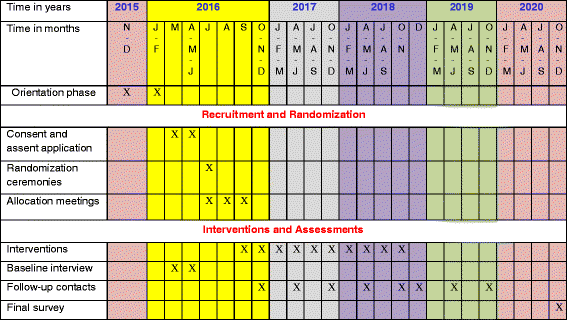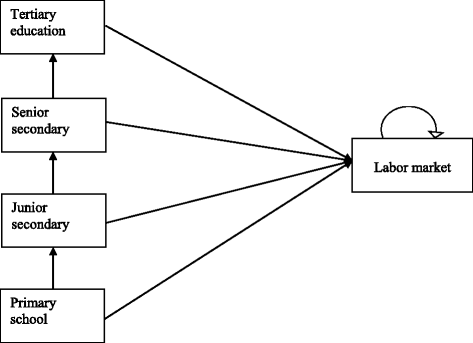Cost-benefit and extended cost-effectiveness analysis of a comprehensive adolescent pregnancy prevention program in Zambia: study protocol for a cluster randomized controlled trial
- PMID: 29258591
- PMCID: PMC5735867
- DOI: 10.1186/s13063-017-2350-4
Cost-benefit and extended cost-effectiveness analysis of a comprehensive adolescent pregnancy prevention program in Zambia: study protocol for a cluster randomized controlled trial
Abstract
Background: Early marriages, pregnancies and births are the major cause of school drop-out among adolescent girls in sub-Saharan Africa. Birth complications are also one of the leading causes of death among adolescent girls. This paper outlines a protocol for a cost-benefit analysis (CBA) and an extended cost-effectiveness analysis (ECEA) of a comprehensive adolescent pregnancy prevention program in Zambia. It aims to estimate the expected costs, monetary and non-monetary benefits associated with health-related and non-health outcomes, as well as their distribution across populations with different standards of living.
Methods: The study will be conducted alongside a cluster-randomized controlled trial, which is testing the hypothesis that economic support with or without community dialogue is an effective strategy for reducing adolescent childbearing rates. The CBA will estimate net benefits by comparing total costs with monetary benefits of health-related and non-health outcomes for each intervention package. The ECEA will estimate the costs of the intervention packages per unit health and non-health gain stratified by the standards of living. Cost data include program implementation costs, healthcare costs (i.e. costs associated with adolescent pregnancy and birth complications such as low birth weight, pre-term birth, eclampsia, medical abortion procedures and post-abortion complications) and costs of education and participation in community and youth club meetings. Monetary benefits are returns to education and averted healthcare costs. For the ECEA, health gains include reduced rate of adolescent childbirths and non-health gains include averted out-of-pocket expenditure and financial risk protection. The economic evaluations will be conducted from program and societal perspectives.
Discussion: While the planned intervention is both comprehensive and expensive, it has the potential to produce substantial short-term and long-term health and non-health benefits. These benefits should be considered seriously when evaluating whether such a program can justify the required investments in a setting with scarce resources. The economic evaluations outlined in this paper will generate valuable information that can be used to guide large-scale implementation of programs to address the problem of the high prevalence of adolescent childbirth and school drop-outs in similar settings.
Trial registration: ClinicalTrials.gov, NCT02709967. Registered on 2 March 2016. ISRCTN, ISRCTN12727868. Registered on 4 March 2016.
Keywords: Adolescent pregnancy; Cash transfer; Catastrophic health expenditure; Cluster randomized controlled trial; Cost-benefit analysis; Early marriage; Extended cost-effectiveness analysis; School drop-out.
Conflict of interest statement
Ethics approval and consent to participate
The main trial protocol was approved by the University of Zambia Biomedical Research Ethics Committee (Ref. number. 021-06-15) and the Regional Ethics Committee of Western Norway (Ref. number. 2015/895). The trial was registered with ClinicalTrials.gov registry on 2 March 2016 (identifier NCT02709967) and the ISRCTN registry on 4 March 2016 (registration number ISRCTN12727868).
Permission to conduct the trial in schools in the study districts and to engage teachers and CHAs/CHWs in the community component was obtained from the Ministry of General Education and Ministry of Health and district education offices in Zambia. All girls and their parents/guardians gave consent/assent to participate in the trial.
For the planned costing sub-studies and the household survey, we will apply for ethical approval from the University of Zambia Biomedical Research Ethics Committee and the Regional Ethics Committee of Western Norway. We will also apply for permission from the relevant authorities in Zambia to conduct studies in the hospitals. All patients and care providers will be interviewed after giving written or verbal informed consent.
Consent for publication
Not applicable.
Competing interests
The authors declare that they have no competing interests.
Publisher’s Note
Springer Nature remains neutral with regard to jurisdictional claims in published maps and institutional affiliations.
Figures


References
-
- WHO . Adolescent pregnancy: Fact sheet No 364. Geneva: World Health Organization; 2014.
-
- Jain S, Kurz K. New insights on preventing child marriage: global analysis of factors and programs. Washngton DC: International Center for Research on Women; 2007.
-
- Mokdad AH, Forouzanfar MH, Daoud F, Mokdad AA, El Bcheraoui C, Moradi-Lakeh M, Kyu HH, Barber RM, Wagner J, Cercy K, et al. Global burden of diseases, injuries, and risk factors for young people’s health during 1990-2013: a systematic analysis for the Global Burden of Disease Study 2013. Lancet. 2016;387(10036):2383–401. doi: 10.1016/S0140-6736(16)00648-6. - DOI - PubMed
Publication types
MeSH terms
Associated data
Grants and funding
LinkOut - more resources
Full Text Sources
Other Literature Sources
Medical

